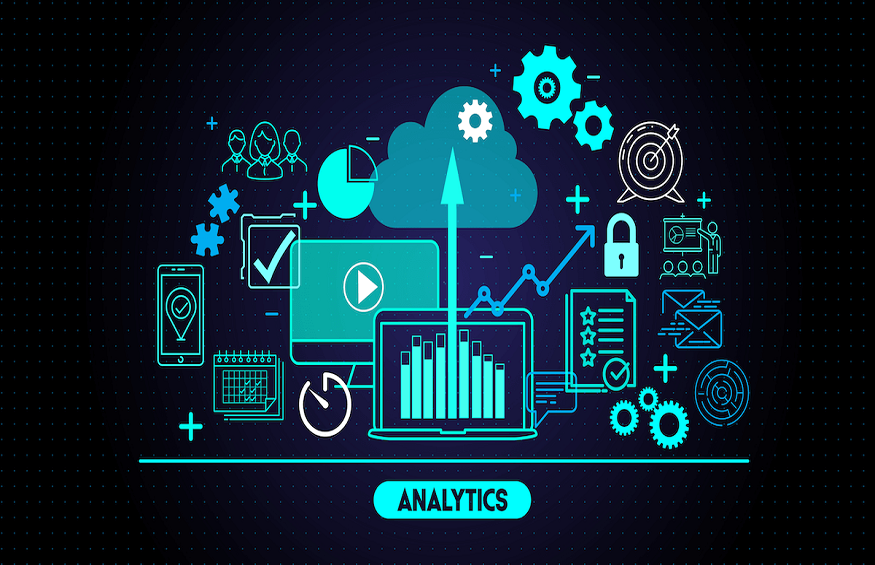Data research and analysis efforts may be accelerated and significant insights can be discovered more quickly by using AI or ML approaches. It helps to clarify each of its main components individually to comprehend it better.

The blog provides information about certain features and the applications of an ai driven data analytics.
Synthetic Intelligence: This general phrase refers to the systems and procedures that support and automate different decisions and actions, or interpret occurrences, using logic-based methods and sophisticated ai driven data analytics.
Machine Learning (ML): it is a development of AI. It employs increasingly complex algorithms that let an automated system “learn” and enhance its operations based on the data it persistently maintains.
Analytics: Data analysis that groups, segments, rates, and forecasts the most likely outcomes of events, such as predictive analytics. Analytics also includes the examination of data from certain domains, such as websites and applications, or from particular business sectors, such as sales or marketing.
Enterprise users may be able to make unprecedented use of data if AI analytics, which combines AI with sophisticated ai driven data analytics, is developed. Organizations can analyze, categorize, and process a variety of data types from a wide range of sources, at whatever scale is required by the use case, thanks to AI and ML-driven data analytics.
Traditional Analytics Versus AI-powered Analytics
Computerized data analysis isn’t a recent development; organizations have been feeding tables of data into mainframes that took up entire rooms for decades. But in terms of the scope and depth of possibilities, they may help organizations realize sophisticated analytics powered by AI or machine learning are nothing short of a whole new world. Because it is untrue, it is not necessary to state that more conventional data analyses are useless. Simply put, the analysis they can offer is constrained.
Significant Uses For AI data Analytics
Some of the most popular and successful applications of ai driven data analytics powered by AI or ML include the following:
1. Sentimental Examination
Businesses may get important insight by examining client feedback provided through website comment sections, social media platforms, surveys, phone calls to customer care departments, and other channels.
In addition to determining if feedback is generally good, negative, or indifferent, ML-based analytics solutions employ natural language processing to assess the urgency of particular circumstances, such as tech support tickets.
2. Recommender Systems
Instead of considering the opinions of users and subscribers, this use case examines their purchasing and browsing patterns. Enterprises may study data points from average session time to content preferences and provide tailored suggestions by using ML algorithms to power their analytics. The most apparent instances of this are probably Amazon and Netflix.
3. Chatbots
ML-powered chatbots make it considerably simpler for customer care staff by automating replies to trivial issues, even while serious consumer inquiries or concerns still require a ticketing system and some kind of substantive involvement.
4. Fraud Prevention
With the use of cutting-edge analysis of transaction and biometric data as well as the numerous patterns it produces, fraud cases in the financial industry that would go unnoticed for days or longer can be found and stopped in real time. This has grown crucial as state-sponsored saboteurs and organized crime groups increasingly use fraud as one of their main business models.
By 2024, 74% of organizations will have “operationalized” AI for specific business goals, according to Gartner’s predictions. Data analytics will very certainly play a significant role in this, which will increase the variety of use cases for AI analytics. Federal authorities, for instance, are examining the possibility of AI- and the analytics of ML-driven for the climate change progression.
How To Use Analytics Powered By AI?
Enterprise AI analytics deployment doesn’t have to be challenging. The next four phases will aid in streamlining the procedure and creating a successful ecosystem and analytical approach.
1. Always Start With The End In Mind
The first step in using ai driven data analytics tools in your company is straightforward: You must be well aware of the requirements of your company and the goals you intend to realize by utilizing AI analytics solutions.
Conducting sentiment analysis should be your aim, for instance, if the head of the customer support team thinks that agents are interpreting clients’ tones and responding in a way that just annoys them more.
Alternately, you would want AI data analytics to carry out a complex root cause study if marketing strategies appear to be successful in moving prospects down the funnel but final conversions are dropping.
2. Obtain Support From Key Players
The organization should then be encouraged to support the introduction of AI data analytics with GPT driven insights. More people than ever before recognize the potential of AI and analytics, but it’s still crucial for the data team and other pertinent business stakeholders to align. The best application of AI analytics requires clear, intelligible training from data analysts and scientists and a workforce that is willing to learn.
3. Identify The Resources You Need
It’s also a good idea to assess your technological resources with GPT driven insights. Although the differences between businesses make specialized AI solutions vital, many companies find it impractical to build these tools in-house. Use third-party ai driven data analytics instead, which are easily accessible from a variety of suppliers.
4. Select The Best Platform For Your Requirements
Finding the ideal data analytics platform that leverages sophisticated machine learning, can be deployed in multi-cloud and hybrid cloud systems, and achieves a good balance between performance and cost is the last piece of the jigsaw.
By expanding machine learning both vertically and horizontally, training its algorithmic models on millions of observations per day, and developing predictive models to serve hyper-segmentation use cases, it can improve your ai driven data analytics. It offers the power, data integration, and flexibility businesses need to make the most of their data and noticeably increase company performance through its interoperability with all major cloud providers, dynamic workload optimization, and pay-as-you-use pricing.
Wrapping Up
Machine learning (ML), an advanced subset of artificial intelligence (AI), has had a significant influence on the IT industry for more than a decade. In parallel, the corporate business sector is now more focused than ever on how analytics can help to generate deeper insight into important performance measures and create a strategy that is actionable and evidence-based on GPT driven insights. It is inevitable that data analytics and artificial intelligence will combine to become AI data analytics.











Leave a Reply
You must be logged in to post a comment.